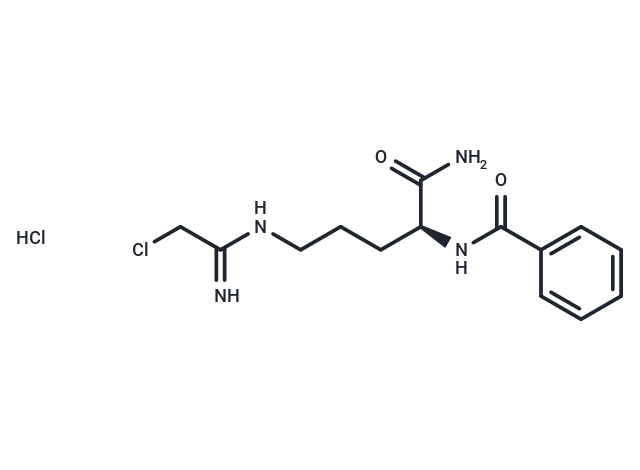Shopping Cart
- Remove All
 Your shopping cart is currently empty
Your shopping cart is currently empty

Cl-amidine hydrochloride is an orally available PAD inhibitor that blocks histone 3 deimination and neutrophil extracellular trap formation and improves survival in septic mice. It induces apoptosis in cancer cells and induces miR-16 to cause cell cycle arrest.

| Pack Size | Price | Availability | Quantity |
|---|---|---|---|
| 1 mg | $37 | In Stock | |
| 5 mg | $89 | In Stock | |
| 10 mg | $147 | In Stock | |
| 25 mg | $289 | In Stock | |
| 50 mg | $469 | In Stock | |
| 100 mg | $679 | In Stock | |
| 200 mg | $945 | In Stock | |
| 1 mL x 10 mM (in DMSO) | $117 | In Stock |
| Description | Cl-amidine hydrochloride is an orally available PAD inhibitor that blocks histone 3 deimination and neutrophil extracellular trap formation and improves survival in septic mice. It induces apoptosis in cancer cells and induces miR-16 to cause cell cycle arrest. |
| Targets&IC50 | PAD4:5.9 μM |
| In vitro | METHODS: Mouse primary splenocytes were treated with 1 μg/mL LPS and 10 μM Cl-amidine. Cell culture supernatants were collected 6 hours after treatment. TNF-α and pro-inflammatory properties of plasma and cell culture supernatants were determined by ELISA. Cytokine expression. RESULTS Cl-amidine decreased the concentration of TNF-α in plasma. At the same time, Cl-amidine treatment could significantly reduce the concentrations of these pro-inflammatory cytokines (IL-1β, IL-6). [1] METHODS: HT29 and TK6 cells were treated with Cl-amidine (0, 5, 10, 15, 25, 50 μg/mL, 24 hours) to detect whether Cl-amidine could induce apoptosis of HT29 and TK6 cells. RESULTS Cl-amidine induced apoptosis of these cells in a dose-dependent manner. [2] |
| In vivo | METHODS: Cl-amidine (40 mg/kg) was administered intraperitoneally to mice 1 hour after cecal ligation and puncture (CLP) to observe the effect of Cl-amidine on protecting mice from sepsis-induced lethality. RESULTS Cl-amidine protected mice from sepsis-induced lethality, and Cl-amidine-treated CLP animals had a higher long-term survival rate. [1] |
| Molecular Weight | 347.24 |
| Formula | C14H20Cl2N4O2 |
| Cas No. | 1373232-26-8 |
| Smiles | Cl.NC(=O)[C@H](CCCNC(=N)CCl)NC(=O)c1ccccc1 |
| Relative Density. | no data available |
| Storage | Powder: -20°C for 3 years | In solvent: -80°C for 1 year | Shipping with blue ice. | ||||||||||||||||||||||||||||||||||||||||
| Solubility Information | DMSO: 19.23 mg/mL (55.38 mM), Sonication is recommended. H2O: 50 mg/mL (143.99 mM), Sonication is recommended. | ||||||||||||||||||||||||||||||||||||||||
Solution Preparation Table | |||||||||||||||||||||||||||||||||||||||||
DMSO/H2O
H2O
| |||||||||||||||||||||||||||||||||||||||||

Copyright © 2015-2025 TargetMol Chemicals Inc. All Rights Reserved.